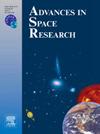Impact of offsets on GNSS time series stochastic noise properties and velocity estimation
IF 2.8
3区 地球科学
Q2 ASTRONOMY & ASTROPHYSICS
引用次数: 0
Abstract
This study systematically investigates the efficiency of RMLE and MLE algorithms for noise model identification using various information criteria and examines the influence of offsets on noise properties and velocity estimation. Through experimental analysis on simulated GNSS time series, we confirm that RMLE and MLE accurately discriminate among four different noise models using AIC, BIC, and BIC_tp information criteria. For time series longer than 15 years, RMLE is recommended as the default method, while MLE outperforms RMLE for short time series when the underlying noise model is FN, PL, or GGM. RMLE proves more sensitive to the RW component than the MLE algorithm, particularly with shorter time series (less than 10 years). We also confirm that the addition of offsets does not transform non-GGM optimal noise models into GGM noise models, further supporting that GGM noise models in GNSS time series are not an artifact and that residual offsets are not the underlying cause of GNSS position time series exhibiting GGMWN characteristics. For selected real GNSS time series without offsets from Extended Solid Earth Science ESDR System, we further confirm that PLWN and FNWN remain the primary noise processes best describing GNSS time series. A noteworthy discovery is the observation of more RW components (approximately 19.22 %) than in previous research with 15-year long-term GNSS time series using the RMLE algorithm. Additionally, we still find GGM as the optimal noise model in the vertical component, ensuring it is real and not an artifact. Furthermore, even with artificially induced frequent offsets, we observe that only about 0.35 % of sites’ optimal noise models change from non-GGMWN models to GGMWN, consistent with the simulated GNSS time series experiments.
偏移量对GNSS时间序列随机噪声特性和速度估计的影响
本研究系统地研究了RMLE和MLE算法使用各种信息准则识别噪声模型的效率,并研究了偏移量对噪声特性和速度估计的影响。通过对模拟GNSS时间序列的实验分析,我们证实了在AIC、BIC和BIC_tp信息准则下RMLE和MLE能够准确区分4种不同的噪声模型。对于超过15年的时间序列,建议使用RMLE作为默认方法,而对于较短的时间序列,当底层噪声模型为FN、PL或GGM时,MLE优于RMLE。RMLE算法比MLE算法对RW分量更敏感,特别是在较短的时间序列(小于10年)下。我们还证实了偏移量的添加不会将非GGM最优噪声模型转换为GGM噪声模型,进一步支持GNSS时间序列中的GGM噪声模型不是人为的,并且残余偏移量不是GNSS位置时间序列呈现GGMWN特征的根本原因。对于从扩展固体地球科学ESDR系统中选择的没有偏移的真实GNSS时间序列,我们进一步证实PLWN和FNWN仍然是最能描述GNSS时间序列的主要噪声过程。一个值得注意的发现是,与之前使用RMLE算法的15年长期GNSS时间序列研究相比,观察到更多的RW分量(约19.22%)。此外,我们仍然发现GGM是垂直分量中的最佳噪声模型,确保它是真实的而不是人造的。此外,即使人为引起频繁偏移,我们观察到只有约0.35%的站点的最佳噪声模型从非GGMWN模型转变为GGMWN模型,这与模拟GNSS时间序列实验一致。
本文章由计算机程序翻译,如有差异,请以英文原文为准。
求助全文
约1分钟内获得全文
求助全文
来源期刊

Advances in Space Research
地学天文-地球科学综合
CiteScore
5.20
自引率
11.50%
发文量
800
审稿时长
5.8 months
期刊介绍:
The COSPAR publication Advances in Space Research (ASR) is an open journal covering all areas of space research including: space studies of the Earth''s surface, meteorology, climate, the Earth-Moon system, planets and small bodies of the solar system, upper atmospheres, ionospheres and magnetospheres of the Earth and planets including reference atmospheres, space plasmas in the solar system, astrophysics from space, materials sciences in space, fundamental physics in space, space debris, space weather, Earth observations of space phenomena, etc.
NB: Please note that manuscripts related to life sciences as related to space are no more accepted for submission to Advances in Space Research. Such manuscripts should now be submitted to the new COSPAR Journal Life Sciences in Space Research (LSSR).
All submissions are reviewed by two scientists in the field. COSPAR is an interdisciplinary scientific organization concerned with the progress of space research on an international scale. Operating under the rules of ICSU, COSPAR ignores political considerations and considers all questions solely from the scientific viewpoint.
 求助内容:
求助内容: 应助结果提醒方式:
应助结果提醒方式:


